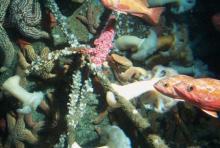California's Offshore Oil and Gas Platforms Serve as Marine Protected Areas, Says New Study Published by UCSB Experts

California's offshore oil and gas platforms act as de facto marine protected areas for some overfished species and serve as a home to a variety of fish and invertebrate organisms, say scientists at the University of California, Santa Barbara.
Biologists Milton S. Love, Donna M. Schroeder and Mary M. Nishimoto have produced a report on a six-year study entitled, Platform Research Report, "The Ecological Role of Oil and Gas Production Platforms and Natural Outcrops on Fishes in Southern and Central California: A Synthesis of Information."
The researchers explain that the invertebrate organisms attach to the beams providing habitat for the fish. At the bottom of the platform is a "shell mound" of mussels and other invertebrates that are dislodged during cleaning or storms.
Off California there are 26 of these platforms, with 23 in federal waters and three in state waters.
Within a few years, some platforms, in Southern and Central California, will stop pumping. As they say in the report, "All oil and gas platforms have finite economic lives and by the beginning of the twenty-first century, seven platforms in Southern California had been decommissioned and a number of others appeared to be nearing the end of their economic lives."
So the question of what to do with the platforms becomes an issue. Should they be removed, have their tops taken off, toppled over, or remain as they are? The authors don't take a stand, deferring the question to the various "stakeholders," including conservationists who want the platforms removed to those who fish the platforms who would like to see them stay. Chapter four covers the possibilities in great detail; it is called a "Guide to Ecological and Political Issues Surrounding Oil Platform Decommissioning in California."
In describing the research, Love explained that few of the many dozens of natural reefs that were studied harbored the large numbers of young rockfish that platforms do. He calls the platforms huge reefs and explained that they are better nurseries than nearby natural reefs. At least 18 species of rockfish use the platforms as a nursery and 35 species make these underwater towers their home.
Love said that there is increasing evidence that some platforms produce fish, while some fish, like kelp bass, tend to relocate there as adults.
He said that with this study, more is known about these platforms than any artificial reef system anywhere, including the Gulf of Mexico.
The study is available on line at www.lovelab.id.ucsb.edu/. Videotapes of the surveys are also available. The study was mainly funded by the Biological Resources Division of the U.S. Geological Survey, part of the Department of Interior. Additional funding came from California Artificial Reef Enhancement Program, which is largely funded by the oil industry.
Related Links



